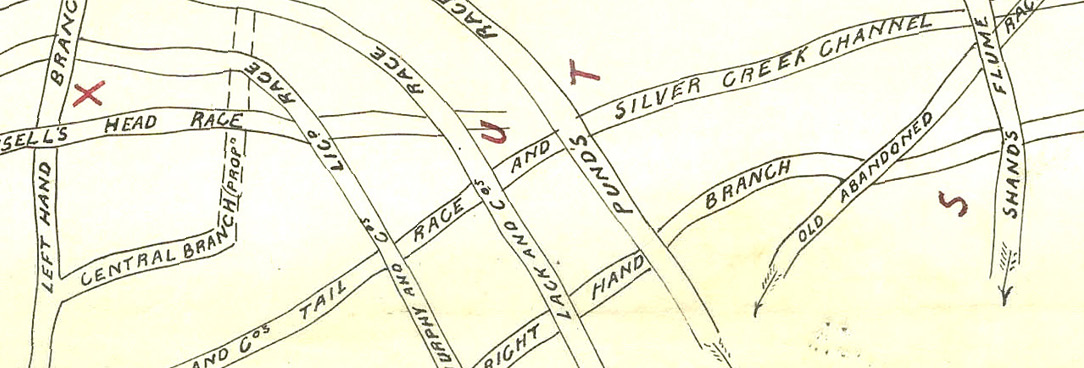Last updated:
‘Historical maps, geographic information systems (GIS) and complex mining landscapes on the Victorian goldfields’, Provenance: The Journal of Public Record Office Victoria, issue no. 14, 2015. ISSN 1832-2522. Copyright © Peter Davies, Susan Lawrence, Jodi Turnbull.
This is a peer reviewed article.
PROV holds a remarkable collection of maps prepared by mining surveyors in the nineteenth century. The maps record water race networks created by alluvial gold miners, who needed large volumes of water to wash gold from the earth. These mining water systems were often very extensive, winding for miles through the hills to divert water to mining claims. The Beechworth (Ovens) goldfield was an important centre of alluvial mining in colonial Victoria and it was here that the most complex water networks were created. Many of the races and dams built by miners are preserved in goldfields landscapes today. We have integrated historical PROV maps of water races at Beechworth into a geographic information system (GIS) to analyse and understand the location and extent of historical water networks. This combination of historical maps and digital technology offers a powerful new tool to help understand the relationships between competing water users and the changes they brought to colonial mining landscapes.
Introduction
Maps and other records held by Public Record Office Victoria (PROV) provide a vital basis for understanding the development of early water supply networks around Victoria associated with gold extraction. Miners’ use of water created the foundation of water management and law in colonial Victoria, which was later adopted around Australia.[1] Practical water management was crucial to the success of gold mining, as miners needed abundant supplies of water to wash gold from the earth. In response to frequent water shortages they built extensive networks of races and dams to capture and store water in creeks and gullies and divert it to their mining claims. Ground sluicing and hydraulic sluicing of alluvial deposits were the main techniques where large volumes of water were needed, along with water for puddling machines, steam engines, water wheels and crushing batteries. By the late 1860s there were almost 4000 kilometres of actively managed races in the seven mining districts of Victoria.[2] The remains of these mining water systems are often well preserved on the goldfields today, with recent analysis shedding new light on the development of water resources in colonial Victoria.[3] The water networks developed by miners were important not only for the wealth in gold they generated but for demonstrating how much water was naturally available and their role in establishing legal mechanisms and a marketplace for water resources. The mining industry was the earliest settler group to develop extensive water networks, laying the foundations for later municipal and agricultural water supply. Understanding this early period provides insight into the origins of Victorian attitudes to water.
Gold miners and government officials developed a system of laws and regulations during this period to manage the distribution of water on the goldfields. Permits, and later, licences entitled miners to control and sell substantial quantities of water for mining purposes. Applications for water rights licences required formal surveys that generated detailed maps of proposed water supply networks. Many of these maps are now held by PROV. They provide an essential basis for understanding the development of mining water supply networks around Victoria.
In this paper we demonstrate how PROV maps have helped reveal the nature of water management and the emergence of complex mining landscapes on the Victorian goldfields. We focus in particular on the Beechworth (Ovens) goldfield as a region with well-preserved mining landscapes and substantial documentary evidence of water distribution networks. Beechworth was an important centre of goldfields water management in nineteenth-century Victoria, where miners built extensive networks of dams and races on an aggregate scale far greater than elsewhere in the colony. While the Coliban System of Waterworks in central Victoria was a government-built project, alluvial miners at Beechworth invested private capital to create complex mining water systems, and they held more than half of all the water rights licences issued in Victoria during the main mining period.[4] Other large, private water providers in Victoria included the Bendigo Water Works Company and the Lal Lal Waterworks Association.[5] Correlating archival maps from Beechworth with modern topographic and cadastral maps (known as geo-referencing) using a computerised geographic information system (GIS) database (MapInfo) has created powerful new tools to help identify and interpret landscapes of water management. The use of digital technology with historical documents has gained momentum since the mid 1990s and today geo-referenced historical maps are being utilised widely in historical research.[6] The integration of modern mapping technologies with conventional paper maps permits detailed analysis of historical mining landscapes and improves our understanding of how miners manipulated water resources.
We begin by describing the nature of mining and water management at Beechworth in the nineteenth century. The Beechworth district was a major alluvial goldfield that produced almost 12 per cent of all the gold found in Victoria.[7] Ground and hydraulic sluicing were used extensively at Beechworth, far more so than at other goldfields during this period. We then review the historical map resources held by PROV that relate to water rights licences at Beechworth and outline our approach to the material, which involves the use of several GIS applications. GIS is a sophisticated computer software system that enables information from many sources to be integrated, analysed and re-combined. In our work we have used geo-referenced maps from PROV, Google Earth imagery, and data from a relatively new laser survey technology, LiDAR, to analyse spatial and temporal relationships between races, dams and reservoirs, and other water features on Victorian goldfields.[8] In this paper we focus specifically on the Beechworth goldfield and on the activities of two miners from the district, John Pund and Donald Fletcher, to understand the complexity of water manipulation in the area and to highlight the benefits of combining PROV’s map resources with modern computer mapping technology.
Gold and water at Beechworth
Gold was first discovered at Beechworth, known initially as the Ovens goldfield, in February 1852.[9] Rushes occurred on numerous creeks and gullies in the area, some of which became established communities including Woolshed, Yackandandah, Stanley and Eldorado. Most of the gold in the area was present as very fine grains or flakes distributed through alluvial deposits, rather than in a thin layer over pipeclay or bedrock as occurred at other goldfields.[10] Recovering gold from the washdirt at Beechworth thus required abundant supplies of water. The area receives an average of 950 mm of rain per annum, which meant that surface and ground water was available through much of the year for mining purposes. Subterranean springs and aquifers also fed surface waterways.
Miners on the Ovens goldfield initially used pans and cradles to wash gold from creek beds. The nature of alluvial deposits, however, meant that ground sluicing was soon adopted as the primary means of recovering gold. Ground sluices diverted water through channels or races and over a working face to loosen and wash away the soil and clay. The dislodged material was shovelled into a sluice-box with riffles or blocks on the base, behind which the heavier particles of gold were trapped. In later years hydraulic sluicing and paddocking were also practised, which left major scars on mining landscapes.
All these methods required substantial volumes of flowing water. To ensure reliable supplies, miners at Beechworth built dams on creeks and gullies to create reservoirs, and dug races to direct water to their mining claims. Water races were simple earth-cut channels, normally about one metre deep, and one to two metres wide, with a V- or U-shaped profile. They were excavated manually by pick and shovel and often extended for five to ten kilometres or more around the hills, falling at a slight gradient to ensure the flow of water. Tunnels, siphons and flumes were also used where necessary. Dams were simple mounds of clay piled across a creek bed, with a pipe and valve inserted in the base to control the outflow. Miners built this entire infrastructure, often at very considerable cost, before they could even begin mining.
Miners could, however, recoup the cost of building dams and races by selling water to other parties. The first recorded miner in Victoria to sell water was John Reilly at Beechworth. He was an Irish-born civil engineer with recent experience of alluvial mining in California. Beginning in 1853 Reilly built several miles of races from Nine Mile Creek (Stanley), in the hills just south of Beechworth, to supply water for his own sluicing operations.[11] He also sold water to miners working downstream, charging each up to seven shillings per day.[12] It was claimed in later years that Reilly earned ‘virtually 100 guineas weekly’ with his local monopoly on water supply.[13] In July 1860 the local mining surveyor reported that one sluice-head of water (about 36,000 gallons or 163,656 litres over 12 hours) brought in rent of about £9 per week.[14]
By the late 1860s miners had excavated more than 740 miles (almost 1200 kilometres) of water races in the Beechworth, Yackandandah, Stanley and Buckland mining divisions.[15] This included some of the longest water races ever built in Victoria, including the Pioneer Ditch which reportedly ran for 70 miles (113 kilometres) from the Kiewa River at Dederang to Yackandandah.[16] There were dozens of main races, often diverting millions of gallons of water out of one watershed and into another on a daily basis. Secretary of Mines Robert Brough Smyth referred to the ‘almost embarrassing multiplicity of small reservoirs’ in the district.[17] Miners at Beechworth had created a complex landscape of mining water systems.
Resources and methods
Historical maps of water race networks derive from several PROV series. One of the most important is VPRS 6784 Water Right Licence Files 1863–1973, created by the Department of Mines, which includes dozens of large maps from the Beechworth area. Locality Plans (VPRS 14969) from the Department of Mines also contain a range of historical maps relating to water management. The Beechworth series date mainly from the 1870s and 1880s, by which time the administrative processes of surveying and map-making were well established. Regulations were based on the Mining Statute 1865 that allowed holders of a miner’s right to apply for a 15-year licence to cut races, build dams and use the water for mining and domestic purposes.[18]
The Beechworth maps principally show the plotting of distances and bearings taken in the field by the local mining surveyor along an approximate course of the race that was initially marked out by the miner applying for the licence (see figure 1). Race alignments typically extended several kilometres from the source of supply (a dam or spring) to the mining claim. Maps frequently show where older, pre-existing races cross the route, along with dams, road and track crossings, nearby property boundaries, flumes over gullies, and springs that increased the water flow. Map sheets were typically about 60 cm long and 90 to 120 cm in width and drawn at a large scale of eight chains to the inch (1:6336) or even four chains to the inch (1:3168). Each one includes a standard statement signed by the mining surveyor (Henry Davidson) endorsing the quality of his work:
I hereby certify that I personally surveyed the race represented by this plan; that the instruments used were a theodolite and chain both in perfect adjustment; that the bearings are taken from the magnetic meridian, the variation of which is given on the plan; that the survey is connected with the nearest available fixed mark in the locality; and that the District Surveyor was furnished with a certified copy of the plan immediately after its completion.[19]
Maps also include summary information about the total length of the race (in chains and links), and the width and area of land to be reserved as ‘gathering ground’, which was not to exceed four acres for every mile in length of the race.[20] The total daily volume of water to be diverted was also provided, which in the case of Beechworth licences was often between 500,000 and 1,000,000 gallons (2,275,000 to 4,550,000 litres).
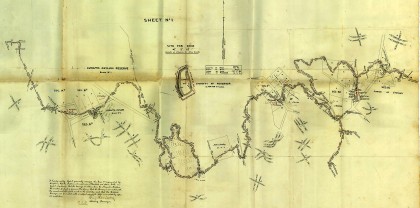
Our research has identified and mapped many of the major races, dams and associated mining water features on the Beechworth goldfield, with a focus on the catchments of Two, Three, Six and Nine Mile creeks.[21] The use of GIS, as a spatially referenced database, is important to help understand rich and complex mining landscapes and provides new ways to visualise and analyse changes over space and time. The GIS software used for this project is MapInfo v.11, with the base data supplied by VicMap (Victorian Government) including cadastral, vegetation, transport and hydrology datasets. Geo-referencing, or registering, historical maps involves digitising the paper map at high resolution and adding control points to the digital map. This can be done either by assigning geographical co-ordinates to known points or linking points to their equivalent position on the digital basemaps. In this case, cadastral boundaries and roads were used most often to assign control points. The original map is then warped slightly to create a ‘best fit’ with the chosen map projection.[22]
Matching historical maps with modern spatial data can result in errors, especially due to distorted or inaccurate mapping in the original maps or those introduced during digitising. Geo-referencing errors were minimised, however, due to the highly accurate nature of water right plans and the high quality digital scans obtained from PROV. Many water rights were originally surveyed and mapped using cadastral (property) boundaries as datums (or reference points). Water right plans that did not display enough cadastral information were not selected for geo-referencing. The accuracy of the geo-referenced maps used here is estimated to average between plus or minus 2 to 4 metres. Geo-referenced historical parish maps, many of which indicate water right boundaries, were also widely used to help map water race networks. For this project the level of accuracy was acceptable for the purposes of both locating features on the ground using iPads and understanding the broader complexity of the water supply systems.
The historical map can then be used to identify features, including races, dams and mining claims, in association with modern geographical markers. Races and dams can be traced and superimposed on topographic maps, Google Earth or LiDAR[23] to reveal the spatial relationships of mining water infrastructure to modern surface features. Geo-referenced historical maps can also be used with iPad applications such as Galileo and Avenza PDF Maps. Galileo is a global positioning system (GPS)[24] application that records points along a path while Avenza imports geo-referenced maps to the iPad. In this way the iPad can be used as an alternative to conventional dGPS, allowing the user literally to walk around the goldfield to the specific location of features shown on the historical map. The process readily permits the identification of relics and visualization of historical landscapes, matching archaeological features with historical maps and texts. The iPad provides a larger screen or interface than dGPS and greater overview of historical and modern features. Alignments of historical water races in GIS can also be combined with LiDAR survey images to reveal relationships between historical features and the modern land surface. LiDAR enables landscape features such as mine shafts, ditches and sluiced areas to be identified even in places where there is heavy vegetation that would otherwise make locating them difficult or even impossible.
Water merchants at Beechworth
In this section we show how combining PROV resources with computer mapping technologies extends our understanding of the activities of two miners at Beechworth, Donald Fletcher and John Pund, who were also major proponents of water manipulation. They and many others like them in the district invested thousands of pounds to create and maintain elaborate mining water systems. The hilly nature of the terrain at Beechworth meant that water races often ran parallel or criss-crossed at numerous points, as miners sought the best alignment to convey their water resources (see figure 2). This led to constant negotiation and argument about access, priority and control over the available water supplies.
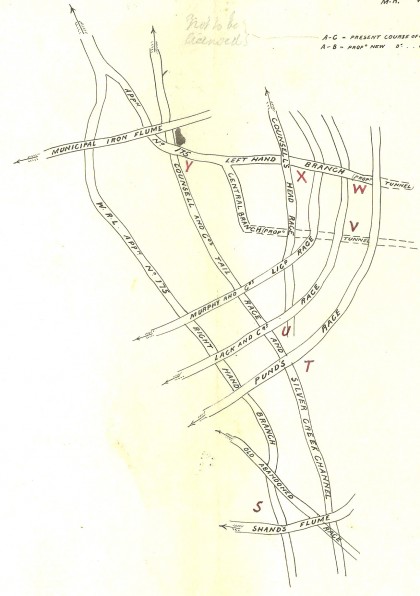
Donald Fletcher was born in Scotland in 1829. He worked in a Glasgow woollen mill before migrating to Sydney on board the Telegraph in 1855 and moving to Beechworth later that year. In 1859 he married Elizabeth Davidson and together the couple had nine children. Fletcher had substantial claims at Pennyweight Flat in Beechworth, and he later mined at Silver Creek, Eldorado, Clear Creek and Yackandandah. He was also among the first to use hydraulic sluicing in the Beechworth district, beginning in 1860.[25] By the 1870s he was a well established figure in the mining community.[26]
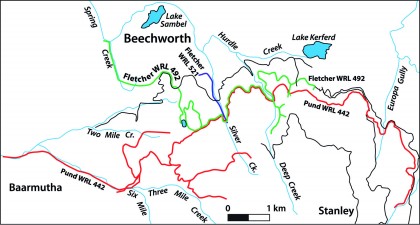
Fletcher began developing his water supply network in the 1860s. In March 1883 he applied to renew his water rights licence. The plan of survey[27] shows the main race and its feeder channels extending from Deep Creek, four kilometres south-east of Beechworth, into a reservoir containing up to 5.7 million gallons (25.9 megalitres) of water (see figure 3). The race then continued past the Beechworth Lunatic Asylum and terminated at a long sluice box and tail race on Spring Creek. The total length of the race network was 12.5 miles (20 kilometres). Along the way the race crossed, or was crossed by, at least twenty other water races and flumes. It drew extra water from a number of tunnels driven into hillsides to tap natural springs, and diverted water across the watersheds of several major creeks.
A few months later, in June 1883, Fletcher applied to renew his water rights licence on Silver Creek.[28] Although this was a much shorter race of a little over two miles (3.8 kilometres), the upper section was deeply entangled with the races of other miners. Over the years a dense weaving of water channels, flumes and tunnels had been constructed by various parties to exploit as much of the available surface and ground water as possible.
By this time a number of large companies exerted considerable control over mining water supplies at Beechworth. These groups made large investments to construct race networks, deep tail races and tunnels, blasting through hard rock to drain alluvial claims and to source spring water. John Pund was one of these entrepreneurs, and although now largely forgotten, he played an important role in developing water supply networks at Beechworth in the nineteenth century.[29]
John Martin Dietrich Pund was born around 1835 in Hamburg, Germany and trained as a sail maker before migrating to Victoria in 1854. He married Emily Ada Sherry in 1859 and the couple had three children, including Percy ‘Jack’ Pund who later worked alongside his father. In 1873 John Pund became naturalised as a British subject.[30] In the early days Pund developed mining interests at Yackandandah, Woolshed and Nine Mile, although his main claims were at Three Mile Creek, where the family settled in 1874.[31] John Pund succeeded in becoming one of the largest and most successful alluvial miners and water barons on the Beechworth goldfield.
The Three Mile Creek mining area, now called Baarmutha, is located about 5 kilometres south of Beechworth. The area was mined in the 1850s but was largely abandoned by the following decade. John Pund, however, saw potential in the area if a better water supply could be obtained. In 1865 he secured a 15-year water right licence (no. 58) with three other miners.[32] Within five years the party had constructed 12 miles (19 kilometres) of water race from the Upper Nine Mile Creek to Three Mile Creek (see figure 4). Pund continued to develop his mining leases and water rights in the following years. In 1881 he obtained a water right licence, which delivered 950,000 gallons to the Three Mile Sluicing area.[33] Several years later he went into partnership with John Alston Wallace, one of Victoria’s major mining entrepreneurs with extensive interests around the colony.[34] By 1895 the pair controlled the major water network supplying the Three Mile and Six Mile diggings. In the early years of the twentieth century Pund & Co were averaging over 1000 ounces of gold per year.[35] Following his death in 1915, the enterprise was eventually sold and became the GSG Amalgamated Co, which continued to sluice the Three Mile claim area until 1950.[36]
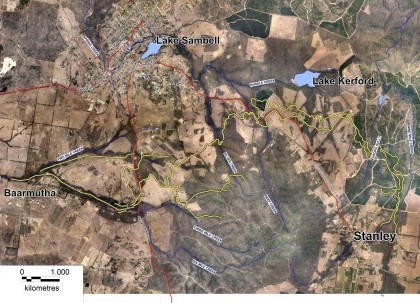
Water races and historical GIS
PROV maps of water races in the Beechworth district contain abundant detail and information. When registered in a GIS database they help reveal not only the scale and route of water races but the relationships between mining water networks and the shape of the land itself. Dense vegetation often makes the identification of remnant water races on the ground difficult, but geo-referenced historical maps, used with an iPad and LiDAR coverage, help to reveal the location and extent of these features. LiDAR images help to identify the physical remains of water systems and mining activity where they would otherwise remain hidden.
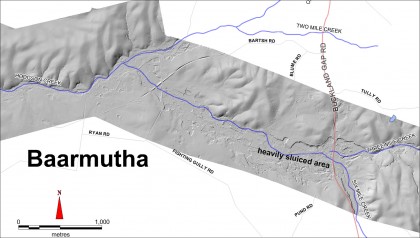
John Pund’s water race system extended for up to 28 kilometres, diverting water out of the Upper Nine Mile Creek, across the headwaters of Spring Creek and into Three Mile Creek. This involved a major diversion from the Kiewa River into the watershed of the Ovens River. The race network included 30 crossings of other races in the area. By the turn of the century miners such as Pund were also being required to build sludge dams to retain the debris from their mining operations. The use of LiDAR with historical maps reveals how these important changes to water management were integrated with mining practice (see figure 5).
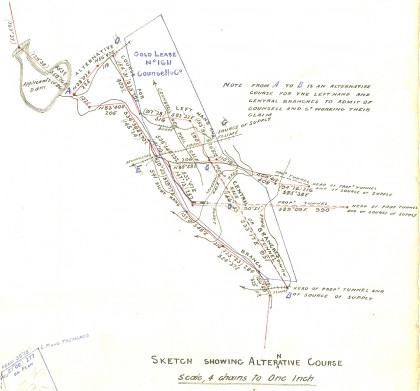
The plan of Donald Fletcher’s water right on Silver Creek (no. 521) shows a complex alternative course that was surveyed to accommodate the sluicing claim of another party (see figure 6). This demonstrates the vital role of the local mining surveyor, who was charged with negotiating conflicts over water access between competing groups. There was often limited space in the hilly terrain to maintain gradients and alignments, and it was the responsibility of the mining surveyor to oversee and plan these landscapes of water management. By the 1880s, maps of water races provided an indispensable record of how mining water systems had developed through space and time.
Beechworth was an important centre of water management on Victoria’s colonial goldfields. Miners built extensive networks of races and dams to secure reliable supplies of water, on a scale far greater than elsewhere in the colony. By the 1880s they continued to hold more than half of all the water right licences on issue and conducted sluicing operations on a massive scale. Their manipulation of surface and ground water via race networks was planned and recorded in detail by local mining surveyors. The maps they created, combined with modern geo-spatial technologies, provide a vital key in understanding the great lengths to which miners went to capture and control critical water resources.
Endnotes
[1] Henry J Armstrong, The Law of Gold-Mining in Australia and New Zealand, second edition, Charles F Maxwell, Melbourne, 1901, pp. 220–221; P Davies and S Lawrence, ‘A mere thread of land: Water races, gold mining and water law in colonial Victoria’, Journal of Australian Colonial History, Vol. 16, 2014, pp. 168–187.
[2] Robert Brough Smyth, The Gold Fields and Mineral Districts of Victoria, facsimile of 1869 edition, Queensberry Hill Press, Melbourne, 1980, p. 547.
[3] P Davies and S Lawrence, ‘Flows of water on a nineteenth-century Australian goldfield’, Water History, Vol. 5, No. 3, 2013, pp. 331–347; P Davies and S Lawrence, ‘The Garfield Water Wheel: Hydraulic Power on the Victorian Goldfields’, Australasian Historical Archaeology, Vol. 31, 2013, pp. 25–32; S Lawrence and P Davies, ‘The Sludge Question: The Regulation of Mine Tailings in Nineteenth-Century Victoria’, Environment and History, Vol. 20, 2014, pp. 385–410; S Lawrence and P Davies, ‘Learning About Landscape: Archaeology of Water Management in Colonial Victoria’, Australian Archaeology, Vol. 74, 2012, pp. 47–54.
[4] G Russell, Water for Gold! The Fight to Quench Central Victoria’s Goldfields, Australian Scholarly Publishing, Melbourne, 2009; Smyth, Gold Fields and Mineral Districts, p. 548; Victoria Government Gazette, No. 44, 16 April 1866, pp. 817–836; Mineral Statistics of Victoria for the Year 1884, Parliament of Victoria, Melbourne, 1885, pp. 54–55.
[5] Russell, Water for Gold!, pp. 69–84; Erica Nathan, Lost Waters: A History of a Troubled Catchment, Melbourne University Press, Melbourne, 2007, p. 27.
[6] Anne K Knowles (ed), Placing History: How GIS is changing historical scholarship, ESRI Press, Redlands, California, 2008; Ian N Gregory and Paul S Ell, Historical GIS: Technologies, Methodologies and Scholarship, Cambridge University Press, Cambridge, 2007.
[7] Brian Lloyd, Gold in the North-East: A history of mining for gold in the old Beechworth Mining District of Victoria, Histec Publications, Hampton East, Vic, 2006, p. 257.
[8] P Davies, S Lawrence and J Turnbull, ‘Harvesting Water on a Victorian colonial goldfield’, Australasian Historical Archaeology, Vol. 29, 2011, pp. 24–32.
[9] J Flett, The History of Gold Discovery in Victoria, Hawthorn Press, Melbourne, pp. 61–5.
[10] Report of the Board Appointed to Advise the Government as to the Best Mode of Developing the Auriferous and Mineral Resources of the Colony, No. 92, Parliament of Victoria, Melbourne, 1879–80, p. 40.
[11] Argus, 13 May 1853, p. 6.
[12] Sydney Morning Herald, 18 May 1853, p. 3.
[13] Alpha, or Charles Grey Bird, Reminiscences of the Goldfields of Victoria, New Zealand and New South Wales in the Fifties and Sixties (in Two Parts),part 1, Gordon and Gotch, North Melbourne, 1915, pp. 35–6.
[14] Mining Surveyors’ Report, Department of Mines, Melbourne, July 1860, p. 16; Report from the Select Committee of the Legislative Assembly, Upon the Ovens Gold Fields Water Company’s Bill; Together with the Proceedings of the Committee and Minutes of Evidence, Parliament of Victoria, Melbourne, 1859–60, p. 10.
[15] Smyth, Gold Fields and Mineral Districts, p. 548; C Woods, Beechworth: A Titan’s Field, Hargreen Publishing Company, Melbourne, 1985, p. 99.
[16] Lloyd, Gold in the North-East, p. 39; Beechworth Water Rights. Report of the Commission Appointed to Enquire into the Subject of Water Rights in the Beechworth District, A–No.28, Parliament of Victoria, Melbourne, 1860–61, p. 2.
[17] Smyth, Gold Fields and Mineral Districts, p. 137
[18] Davies and Lawrence, ‘A mere thread of land’, pp. 180–2.
[19] PROV, VPRS 6784/P8 Water-Right Licence Files, Unit 1, File 488 Water Right.
[20] Davies and Lawrence, ‘A mere thread of land’, p. 179.
[21] This study is part of a larger research project, ‘Cultural landscapes of colonial water management in Victoria’s Central Highlands’, funded by the Australian Research Council and conducted with the support of La Trobe University. Further research results on Beechworth are presented in J Turnbull, P Davies and S Lawrence, Historical Archaeology of Water Management at Beechworth, La Trobe University, Report No. 4473, 2014.
[22] J Turnbull, ‘Historical GIS – Examples from the Creswick Goldfields’,Geospatial Science Research, Vol. 2, 2012.
[23] LiDAR is a remote sensing technology used to create highly accurate three-dimensional maps of the Earth’s surface. It uses laser technology to record images of the ground surface without vegetation obscuring the image. LiDAR is effectively an ‘x-ray’ of the Earth’s surface that reveals topographic features such as hills and river beds in high resolution.
[24] GPS (global positioning system) is a technology that uses satellite data to locate users on the Earth’s surface. Differential GPS (dGPS) is an enhanced version with a higher level of accuracy and precision.
[25] Lloyd, Gold in the North-East, p. 156. The party of Chappell and Son were reported to be using two hydraulic hoses on Europa Gully in August 1859 but with only limited water pressure, Reports of the Mining Surveyors and Registrars, Beechworth Mining District, August 1859.
[26] Woods, Beechworth, pp. 98–9, 159. When Fletcher died in 1904, he was still actively engaged in developing a large sluicing claim at Yackandandah,Ovens and Murray Advertiser, 9 July 1904, p. 7c.
[27] PROV, VA 2719 Department of Mines, VPRS 6784/P3 Water Right Licence Files 1863–1973, Unit 1, File No. 492 WR.
[28] PROV, VA 2719 Department of Mines, VPRS 6784/P3 Water Right Licence Files 1863–1973, Unit 1, File No. 521 WR.
[29] John Pund is not mentioned in the major historical monographs on Beechworth history, including Tom Griffiths, Beechworth: An Australian country town and its past, Greenhouse Publications, Melbourne, 1987, Carole Woods,Beechworth, A Titan’s Field, Hargreen Publishing, Melbourne, 1985, or Lloyd,Gold in the North-East.
[30] J Hilderbrand, The Baarmutha Story, second edition, PB Publishing, Gisborne, Victoria, 2012, p. 98.
[31] Report of the Board Appointed By His Excellency The Governor in Council to Inquire into the Sludge Question, No. 10, Parliament of Victoria, Melbourne, 1887, p. 3, Q. 22–25.
[32] Ovens and Murray Advertiser, 10 October 1865, p. 4a; Victoria Government Gazette, 16 April 1866, No. 44, Parliament of Victoria, Melbourne, p. 820.
[33] PROV, VA 2719 Department of Mines, VPRS 6784/P4 Water Right Licence Files 1863–1973, Unit 2, File No. 442 WR.
[34] Lloyd, Gold in the North-East, pp. 21–34; C Woods, ‘Wallace, John Alston (1824–1901)’, in Australian Dictionary of Biography, Vol. 6, G Serle and R Ward (eds), Melbourne University Press, Melbourne, pp. 345–6
[35] Lloyd, Gold in the North-East, p. 156.
[36] Mining and Geological Journal, Vol. 4, No. 2, September 1950, p. 38.
Material in the Public Record Office Victoria archival collection contains words and descriptions that reflect attitudes and government policies at different times which may be insensitive and upsetting
Aboriginal and Torres Strait Islander Peoples should be aware the collection and website may contain images, voices and names of deceased persons.
PROV provides advice to researchers wishing to access, publish or re-use records about Aboriginal Peoples
